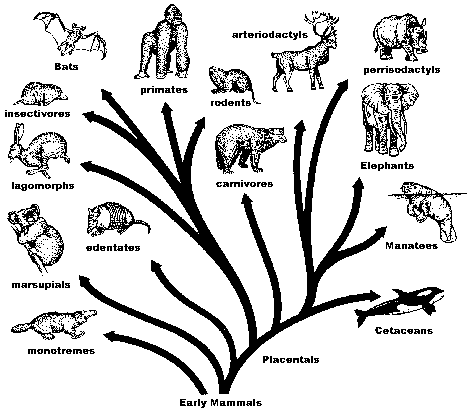
We're now getting numbers of a magnitude that are more accessible to us. Thirty-five thousand is a number that can have meaning for us (e.g. consider income tax calculations!).

How much diversity in organisms will 35,000 evolutionary units allow for? Let us take a very conservative approach and say that, instead of a large scale evolutionary change such as a elephant size change (with the consequent production of many intermediate species), an evolutionary unit only results in any single species splitting into 2 species. That is, for every species that exists at the start of an evolutionary unit there are 2 species emerging from the end of that unit. (Certainly, this oversimplistic assumption isn't true for many organisms. For example, some sharks, turtles and the coelacanth have remained unchanged for very many instants; fossils of these animals show very little difference from modern species. These are the so- called «living fossils». Of course, many other organisms will have undergone more than 1 species split or speciation event during 100,000 years. Also, the extinction of species is ignored. However for the purposes of this discussion, which is to get a very rough idea of how much diversity might have been allowed during the available geologic time, let's see how far we can go with it. We'll come back to it shortly.)
In this scenario, the number of species doubles with each evolutionary unit; after one unit there exists 2 species, after 2 units there exists 4 species, after 3 units there exists 8 species and so on. To calculate the diversity of any given evolutionary unit simply raise 2 to the power of that unit. For example, how much diversity was there after 10 evolutionary units? Raise 2 to the power of 10 to find the answer: 210 = 1024 species.
So then, how much diversity has been allowed in the 35,000 evolutionary units that have already occurred. From our assumptions this has allowed for 235,000 species to have evolved. (By the way, don't bother to try and calculate this number to base 10, it's much too large a number for your calculator!) (Edited in June, 2020. It's 1010535) We are now back to inaccessible numbers; 235,000 is a larger number than the number of protons in the known universe (about 1080). It is astronomically larger than astronomically large numbers! Certainly it is greater than the actual diversification of life that has occurred.

However I hope, with this simplistic argument, that you've come to realize that the time that the evolutionary processes have had to operate within is more than sufficient to completely account for all the vast diversity of life, from prokaryotes such as bacteria, mycoplasmas and blue-green algae (or cyanobacteria) to eukaryotes such as slime molds, lichens, sequoias, sea cucumbers, lobsters, pterodactyls and you.